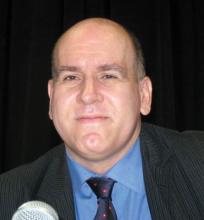ORLANDO – Donors of bone marrow or peripheral blood stem cells can rest assured that their generous acts are unlikely to have any lingering negative consequences to their own health, investigators reported at the annual meeting of the American Society of Hematology.
A survey collecting 55,228 observation-years of health data on 12,559 donors of bone-marrow and/or peripheral blood stem cells (PBSC) to unrelated recipients suggests that despite receiving granulocyte–colony-stimulating factor (G-CSF), donors are not at increased risk for hematologic malignancies or other significant health problems down the road, said Dr. Alexander H. Schmidt of the DKMS German Bone Marrow Donor Center in T?bingen, Germany.
Looking at standard incidence ratios (SIR) for leukemias, lymphomas, plasmocytoma, and lung cancer, the authors found no evidence of increased risk associated with donation.
Although bone marrow donors (but not PBSC donors) had a threefold higher incidence of malignant melanoma compared with the general German population, this finding was likely a statistical artifact, "because there is no mechanism available that would explain how bone marrow donation could increase the risk of development of malignant melanoma," Dr. Schmidt said at a media briefing where DKMS was described as the largest bone marrow donation center in the world.
In addition, the incidence of lung cancer was lower than expected among donors, who may be more focused on health concerns than nondonors and thus less likely to smoke.
"We found no evidence that bone marrow or PBSC donation might be unsafe procedures, so there’s no need to change policies from our point of view," he said.
[Treatment-Related Death Toll Casts Doubt on "Auto-Allo" Transplants in Myeloma]
A handful of studies has suggested that hematopoietic agents such as G-CSF may increase risk for hematologic malignancies among healthy donors who receive them, Dr. Schmidt said.
For example, Dr. Charles L. Bennett and colleagues at the Northwestern University Feinberg School of Medicine in Chicago reviewed findings on donors who developed hematologic malignancies 1-5 years after receiving hematopoietic agents. The authors found that "while a causal relationship with hematological malignancies cannot be demonstrated, long-term follow-up among healthy individuals who receive hematopoietic growth factors is needed." (Br. J. Haematol. 2006;135:642-50).
But to tease out potentially harmful effects with any degree of certainty requires a large sample of donors who are willing to participate in a survey, Dr. Schmidt said. To capture as many donors as possible, he and his colleagues devised a simple survey asking donors about their general health, hospitalizations or long-term medical therapy (and the underlying disease) since donation, prescription drugs they took regularly or for a minimum of 4 weeks since donating, and whether they were willing to donate again.
They received replies from 81.3% of the 15,456 donors to whom they mailed the questionnaires, for a total of 12,559 completed and returned responses. That translated into 30,777 observation-years for 8,730 PBSC donors, 23,037 observation-years for 3,556 bone marrow donors, and 1,414 observation-years for 273 donors of both marrow and PBSC. Median follow-up time since donation was 3.3 years.
Overall, 95.1% of PBSC donors rated their health as very good or good, as did 96.0% of marrow donors, and 92.2% of those who gave both PBSC and marrow (comparison of PBSC and marrow donors, chi-squared test, P = .03)
PBSC donors had significantly fewer hospitalizations or new prescriptions than did bone marrow donors in a univariate analysis (chi-square tests, P less than .001), but this difference did not hold up in multivariate analysis. Because there were significantly more men and younger PBSC donors than bone marrow donors, the differences detected in health-related problems between the donor groups in the univariate analysis may be attributable to differences in sample characteristics, the investigators said.
A total of 85 malignancies were reported: 50 among 48 stem-cell donors, 31 in marrow donors, and 4 in donors of both. Six of these malignancies were hematologic: two cases of Hodgkin’s disease, both occurring in PBSC donors; one plasmocytoma in a PBSC donor; one acute myeloid leukemia in a bone marrow donor; one non-Hodgkin’s lymphoma in a bone marrow donor; and one chronic myeloid leukemia in a dual donor. (In addition, the investigators said they learned of 21 more donor malignancies in reports from donor centers; 5 of these were hematologic.)
The SIR for all malignancies among all donors was 0.99. There were no significant differences in the incidences of leukemia, non-Hodgkin lymphoma, plasmocytoma, or Hodgkin’s disease from those of age- and gender-adjusted incidences in the German population.
Dr. Schmidt said that the data exclude the possibility of a threefold or greater risk for leukemia in PBSC donors.


